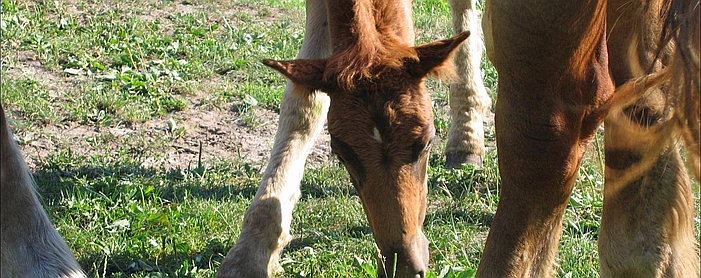¢Post-partum straining → uterine [Uterus: prolapse] or bladder prolapse.
¢Retained placenta → septicemia/metritis/laminitis complex .
¢Surgical complications:
ØIncisional infection and/or dehiscence.
ØAnesthetic emergencies and fractures sustained during recovery .
ØPeritonitis due to surgical contamination or uterine wound dehiscence.
ØPost-operative adhesions.
ØHemorrhage from uterine incision.
ØPost-operative shock and disseminated intravascular coagulations (DIC)
The chances for having a live foal following a C-section vary greatly depending how long it takes to get the mare to the referral hospital. If the foal survives the surgery, he'll need oxygen, because he needs to wake up from the anesthesia given to the mare.
AFTERCARE AND RECOVERY
¢The aftercare for the mare is similar to that of a colic surgery, on the ventral midline of the belly, though with a longer incision.
¢Because of this long incision, the mare’s exercise must be limited during the first part of her recovery, to give the tissues a chance to heal.
¢ keeping her in a stall for the first month. Then she can have a little bit of turnout during the second month. The time frame on these recommendations will vary a little bit from surgeon to surgeon, but it mainly has to do with how quickly the body wall heals. By the third month the mare can usually have free turnout
¢The aftercare for the mare will include antibiotics and anti-inflammatory medication to help reduce the effects of shock. She will also be given oxytocin to help her shed the placenta.
¢Mares can be fertile after a C-section but are probably less so than the average mare that season. If the mare had a C-section in May, for instance, it is less likely that she would breed back again that year. It might take her until next year to be fully ready to breed again, and the owner is better off just waiting. If she had a C-section in January or February, however, there might be more chance of getting her rebred that season.
¢An 80 to 90 % survival rate can be expected in mares that have undergone cesarean section.Foals survival rates after cesarean delivery range from 10 to 30% in the case series for which a 10% foal survival was observed 33% of the foals were delivered alive but fetal deformity was a common for euthanasia.Fertility after C-section appears to be reduced substantially.However conception rates after elective cesarean section appear to be higher than observed after after emergency C-section.
¢Labor in the mare is explosive, and if something goes wrong it can be very stressful to both the mare and the owner. For the inexperienced owner with a pleasure horse or show mare, this can be very traumatic, and they may decide they don’t want to risk going through this again.
¢ It’s usually not the fault of the mare, unless it’s a situation where she has a pelvic obstruction like an old fracture. If it’s due to something anatomic in the mare, then yes, she’d need a C-section for every foal, and she might not be your ideal broodmare.

